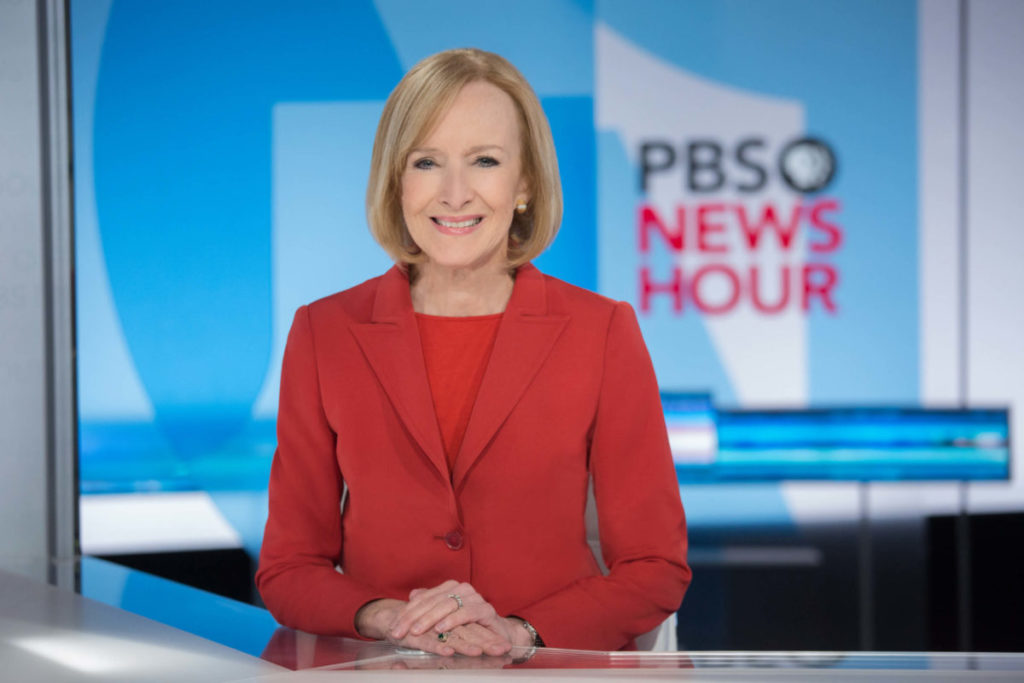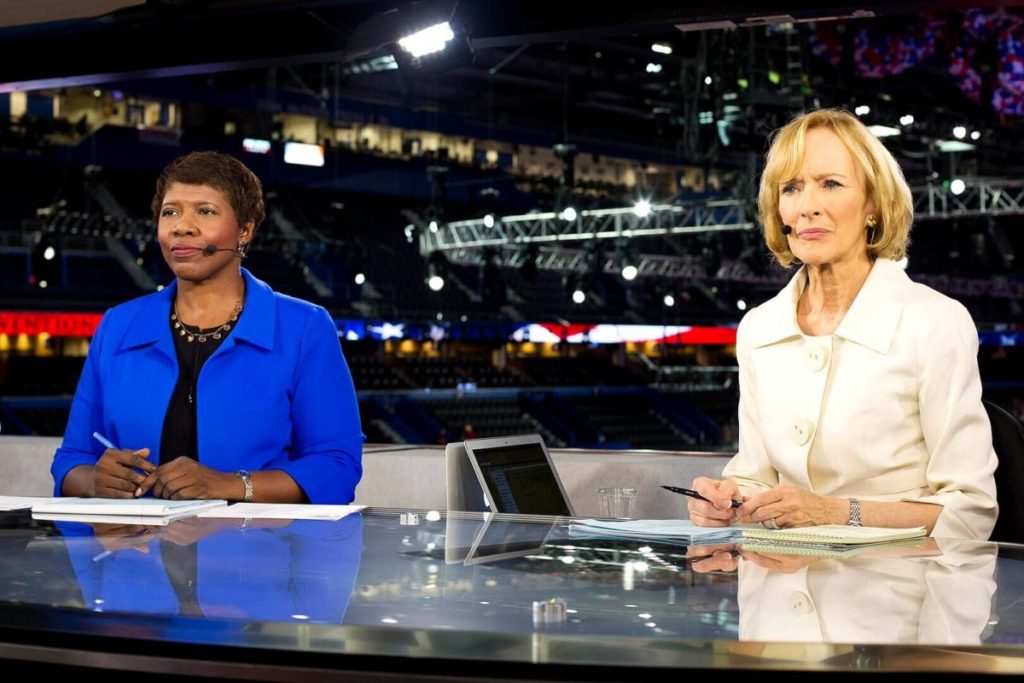
When Judy Woodruff, the longtime anchor of the PBS NewsHour, broadcast her final send-off in December 2022, some viewers might have assumed the 76-year-old would go gently into that good night. Sure, Woodruff mentioned taking up a few reporting projects – namely, delving into the country’s deep political divide, and exploring the challenges faced by people with disabilities.
But this was … goodbye. Right?
It turns out, Woodruff has not left the building. Not even close. Since signing off as anchor, Woodruff has filed over 10 in-depth reports on distrust and divisiveness for her new NewsHour series, “America at a Crossroads.” She also kicked off her “Disability Reframed” series with a weighty look at wait lists for long-term home care. Oh, and she interviewed President Joe Biden in February. Does she have any retirement plans? “No, no, no,” Woodruff says, during a recent interview. “That’s not in my lexicon or vocabulary, whatever. I’m never just going to stop everything. I can’t imagine that.”
Work, it turns out, is not only what drives Woodruff, but how she views her life. Much like a TV news show, “I look at my life in terms of segments,” she says. There were her earliest days as a candy striper and part-time cashier, then her Duke University years as a Congressional intern, then finally a job in the newsroom, at NBC, CNN and PBS. “I’ve always worked,” she says. “I love what I do.”
So why step back as anchor – a position so powerful she’s been parodied on Saturday Night Live? While age has something to do with it (“I just thought [76] was a good round number”), more pressing was the election cycle. Having covered every presidential race since 1976, Woodruff wanted to leave the anchor desk right after midterms to give “somebody else” time to prep for 2024. Her replacements are Amna Nawaz and Geoff Bennett. “I just thought they deserve the time to break-in, get comfortable, and then get ready to cover another big election,” she says.
‘We Already Have a Woman Reporter’
Over the course of five decades, Woodruff has covered political news aggressively while maintaining civility, often facilitating a type of respectful discourse rarely seen on competing networks. Her memorable career moments are many, from covering the 1981 attempted assassination of President Ronald Reagan (she heard the shots) to moderating the 1988 vice-presidential debate where Senator Lloyd Bentsen uttered “You’re no Jack Kennedy” to Dan Quayle, to anchoring NewsHour from her home (for over a year) during the Covid pandemic. And then there’s this claim to fame: In 2013, she and Gwen Ifill made history as the first two women to co-anchor a nightly news show.

When Woodruff graduated from college in 1968, the national conversation on women’s rights had just begun to escalate. “When I started out, there were so few women,” she says. “I’ve often said, though, that if I had come along 10 years earlier, I don’t think there would have been any doors open for me.”
Her first job in television was working as the newsroom secretary at a TV station in Atlanta. “At that point, they had one woman reporter at each station in Atlanta,” she recalls. “I started pestering the news director to let me go out with a reporter and a camera crew, just to observe. His answer was, ‘Well, why would you want to do that, Judy? We already have a woman reporter.’ This was 1969.”
Her pestering paid off, however, when the local CBS affiliate lost their woman reporter – “she was leaving to have a baby,” Woodruff recalls – and she got the job. “I thought I had died and gone to heaven,” she says. “There I was covering the Georgia State legislature and Atlanta City politics. And what an interesting time, 1970, in the throes of – still – the Civil Rights movement.”
The station director soon hired an additional woman, this time a Black journalist. “He was quite enlightened,” Woodruff says. “Two whole women reporters!” It almost made up for all the jobs she didn’t get, such as the openings she applied for at radio stations around the country. “A few wrote back and said, ‘Well, we don’t think a woman’s voice is authoritative, so we don’t hire women to do this,'” she says of the blatant discrimination. “It was right out in the open.”
But things began to noticeably change in the ’70s, when stations “started to be under pressure from the Federal Communications Commission to hire women,” she says. “Interestingly, Richard Nixon pushed the FCC.” That helped usher in an era of powerhouse women in journalism, including Diane Sawyer, Lesley Stahl, Andrea Mitchell, Rita Braver and Jane Pauley.
It wasn’t until 2013 that Woodruff and Ifill had their historic moment, though. When I asked if she thought that was surprisingly fast – all things considered – or a long time coming, she paused to consider.
“We had mixed feelings, because on the one hand we wanted to celebrate. But on the other hand, it took a long time and it took a lot of hard work,” she says. “A lot of women were just, frankly, cast by the wayside along the way. We were very, very grateful to be where we were.”
Supporting Women Journalists
Around the time the Berlin Wall came down in 1989, Woodruff and a group of prominent women journalists from 50 countries saw a need to support women in news media and founded the International Women’s Media Foundation. “We knew it was a time of democracy expanding,” she says, which would lead to more press freedom in places like the Middle East and Latin America. “And, we thought, when that’s happening, we want to make sure women are part of the picture, because it’s so easy for women to get overlooked – especially in parts of the world where women are treated as second-class citizens.”
The IWMF remains active today, providing networking and training for women in news media, advocating for freedom of the press, and calling out continued bias in news coverage. A recent Instagram post reminds followers to #CheckYourBylines, as “the news is predominantly told from white, male perspectives. … Take action to diversify the news you consume.”
“I’m so proud of what it’s become,” Woodruff says. “Every year, we recognize women journalists who put their lives on the line to report, and it’s just stunning what women are having to put up with.” IWMF runs numerous grant programs to fund female reporters, including the Kim Wall Memorial Fund, named for the journalist who was brutally murdered while reporting in Denmark, and the Elizabeth Neuffer Fellowship, named for Boston Globe correspondent who was killed while reporting in Iraq in 2003.
As for her own work, Woodruff plans to stay at NewsHour until the end of 2024. After that? She’s not sure. “I’m looking at the next project. Have you got any ideas?” (When I suggest she start her own media company, Woodruff agrees that it would be an obvious thing to do. “Absolutely,” she says. “I’ve got plenty of time to figure out what that looks like.”)
One thing, of course, she will not be doing is the “R” word. She and her husband, former Bloomberg editor Al Hunt, recently took a weeklong vacation to Italy. While it was “fabulous,” she is not planning to live la dolce vita – or even take another vacation – anytime soon. In fact, if she had her way, she would be “literally” hitting the road for her “Crossroads” series, crisscrossing the country in an RV. (Her husband nixed that idea.) Instead, she’ll simply plan more work trips, including to the South and the Pacific Northwest, so she can meet ordinary Americans and talk about partisan divides.
“I’m reconnecting with real people, which to me is a privilege,” she says, especially after so many years in the studio. To stop doing the work she loves isn’t “in my DNA,” she says. “I’ll be busy doing something – maybe on a different schedule, a different rhythm – but I’m definitely not planning to [stop].” ◼



